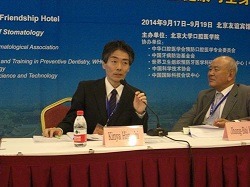Significance of the approach to bad breath and Oral Malodor Syndrome
Higuchi K.†, †††, Honda S. ††, †††
(†Higuchi Dental Clinic Co. Med. ††Honda Dental Co. Med. †††Excellent Breath Alliance Clinics)
 |
|
発表風景
|
〔Purpose〕
A lot of patients who sensed their oral malodor have visited our bad breath
clinics. It is important to distinguish the bad breath and Oral Malodor
Syndrome. The former means an offensive odor, while the later means distress
as a result from having bad breath. Most of the patients kept good oral
hygiene and their breath did not smell bad. Their pathology was classified
as physiological halitosis. Abnormal intraoral sensation and anxious behaviors
of others made them conscious about their malodor and there was a need
to solve this problem for them. They have less offensive odor and more
serious anxiety about the oral malodor than the patients who have pathological
halitosis.
|
 |
|
議長の先生方と
|
We developed a new system of treatment for physiological oral malodor as follows.
1) Removal of pathological factors by correction of oral care habits, correction of a life style, relaxation of perioral and parapharyngeal muscles and rehabilitation of oral physiological functions
2) Deodorization with a mouthwash containing chloride dioxide, another mouthwash containing low molecular polyphenol and a streptococcal probiotic product
3) Recovery from abnormal intraoral sensation
4) Psychological support using cognitive behavioral therapy
5) Periodic follow-up after disappearance of anxiety for halitosis
〔Methods〕
Organoleptic tests, visual analogue scale for anxiety (VAS-A) mechanical
breath gas monitoring (BB checkerR), analysis of anaerobic hydrolytic activity
(BANA PerioR) and salivary tests were carried out on every visit for 261
patients who received halitosis treatment three times within one and a
half months.
〔Results〕
The results were that the oral malodor was observed to decrease in intraoral gas and exhalation according to the organoleptic tests. It was also decreased in intraoral gas according to the breath gas monitor. Subjective anxiety about the halitosis showed VAS-A relieved. Anaerobic hydrolytic activity on the palatal tonsil and in the gingival sulcus decreased. Static salivary flow increased, while yellowish turbidity and salivary smell decreased. The mouth rinse was useful to remove the malodor. Improving abnormal sensations in the oral and pharyngeal cavities and correcting the cognitive vision of oral malodor softened the fear of physiological halitosis. Our comprehensive methods were useful for oral malodor.
 |
|
議長を務めた
|
〔Discussion〕
Because most people have an interest in halitosis and a fear for it, patients
strongly feel advancement of QOL when the oral malodor syndrome is in remission.
These patients will pay more attention to oral health and continue to have
oral maintenance. It is easy to establish a model of preventive dentistry
through the treatment of oral malodor syndrome. It is also said that the
examination of halitosis leads to the discovery of diseases in dentistry,
oto-rhino-laryngology and internal medicine in early stage.
|
















 ひぐち歯科クリニック
ひぐち歯科クリニック